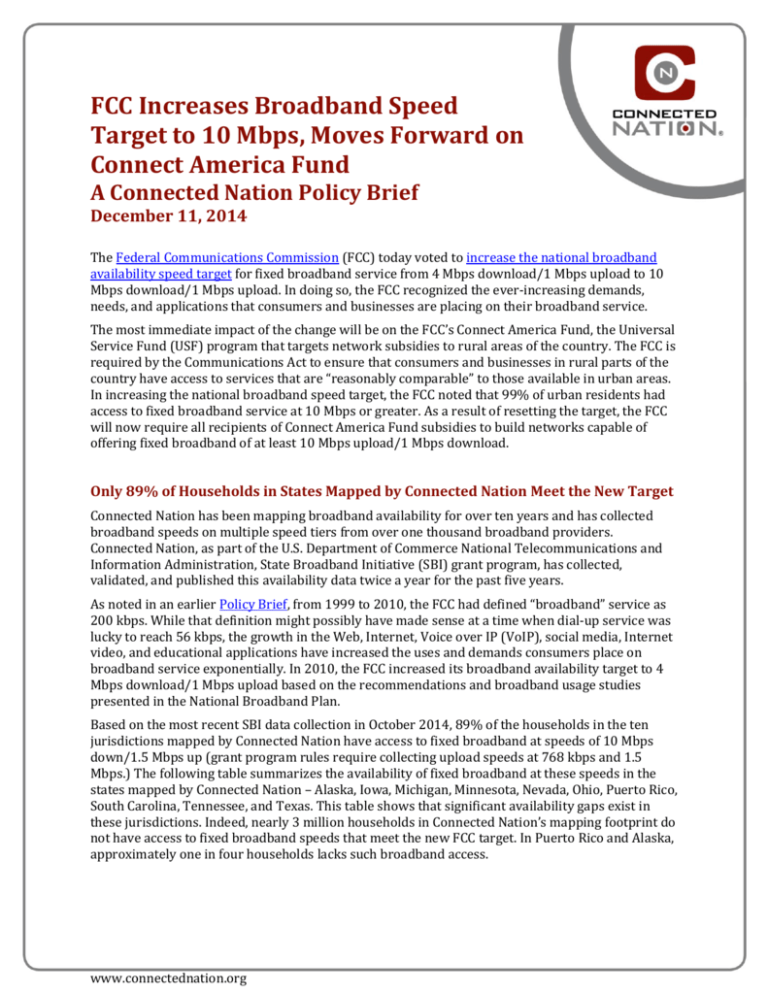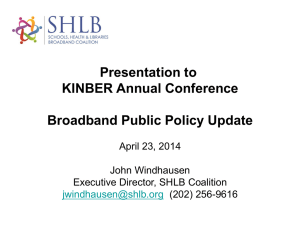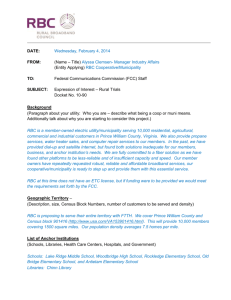FCC Increases Broadband Speed Target to 10 Mbps, Moves
advertisement

FCC Increases Broadband Speed Target to 10 Mbps, Moves Forward on Connect America Fund A Connected Nation Policy Brief December 11, 2014 The Federal Communications Commission (FCC) today voted to increase the national broadband availability speed target for fixed broadband service from 4 Mbps download/1 Mbps upload to 10 Mbps download/1 Mbps upload. In doing so, the FCC recognized the ever-increasing demands, needs, and applications that consumers and businesses are placing on their broadband service. The most immediate impact of the change will be on the FCC’s Connect America Fund, the Universal Service Fund (USF) program that targets network subsidies to rural areas of the country. The FCC is required by the Communications Act to ensure that consumers and businesses in rural parts of the country have access to services that are “reasonably comparable” to those available in urban areas. In increasing the national broadband speed target, the FCC noted that 99% of urban residents had access to fixed broadband service at 10 Mbps or greater. As a result of resetting the target, the FCC will now require all recipients of Connect America Fund subsidies to build networks capable of offering fixed broadband of at least 10 Mbps upload/1 Mbps download. Only 89% of Households in States Mapped by Connected Nation Meet the New Target Connected Nation has been mapping broadband availability for over ten years and has collected broadband speeds on multiple speed tiers from over one thousand broadband providers. Connected Nation, as part of the U.S. Department of Commerce National Telecommunications and Information Administration, State Broadband Initiative (SBI) grant program, has collected, validated, and published this availability data twice a year for the past five years. As noted in an earlier Policy Brief, from 1999 to 2010, the FCC had defined “broadband” service as 200 kbps. While that definition might possibly have made sense at a time when dial-up service was lucky to reach 56 kbps, the growth in the Web, Internet, Voice over IP (VoIP), social media, Internet video, and educational applications have increased the uses and demands consumers place on broadband service exponentially. In 2010, the FCC increased its broadband availability target to 4 Mbps download/1 Mbps upload based on the recommendations and broadband usage studies presented in the National Broadband Plan. Based on the most recent SBI data collection in October 2014, 89% of the households in the ten jurisdictions mapped by Connected Nation have access to fixed broadband at speeds of 10 Mbps down/1.5 Mbps up (grant program rules require collecting upload speeds at 768 kbps and 1.5 Mbps.) The following table summarizes the availability of fixed broadband at these speeds in the states mapped by Connected Nation – Alaska, Iowa, Michigan, Minnesota, Nevada, Ohio, Puerto Rico, South Carolina, Tennessee, and Texas. This table shows that significant availability gaps exist in these jurisdictions. Indeed, nearly 3 million households in Connected Nation’s mapping footprint do not have access to fixed broadband speeds that meet the new FCC target. In Puerto Rico and Alaska, approximately one in four households lacks such broadband access. www.connectednation.org Fixed Broadband Availability (10 Mbps Download/1.5 Mbps Upload) State 258,058 1,221,576 3,872,508 2,087,227 1,006,250 4,603,435 1,376,531 1,801,181 2,495,552 8,922,933 Unserved Households 65,777 236,715 281,665 175,617 47,779 465,563 304,655 217,720 303,843 828,101 Served Households 192,281 984,861 3,590,843 1,912,060 958,471 4,137,872 1,071,876 1,583,461 2,189,709 8,094,832 27,643,251 2,926,985 24,716,266 Total Households Alaska Iowa Michigan Minnesota Nevada Ohio Puerto Rico South Carolina Tennessee Texas Total Percent Served 74.51% 80.62% 92.73% 91.61% 95.25% 89.89% 77.87% 87.91% 87.81% 90.72% 89.41% Impact on Connect America Fund Commitments The FCC has been using the prior 4 Mbps/1 Mbps broadband target in implementing the Connect America Fund. Changing the target to 10 Mbps/1 Mbps will significantly impact the program’s operation, and today’s FCC vote highlighted some of those changes. Most notably, the FCC will now require all Connect America Fund subsidy recipients to use those subsidies to build fixed networks capable of delivering speeds of 10 Mbps down/1 Mbps up. The impact of this change will first be felt in “Phase II” of the Connect America Fund, which the FCC announced will begin in early 2015. As described in prior Policy Briefs, Phase II of the Connect America Fund will offer large, incumbent telephone companies nearly $1.8 billion per year in subsidies in exchange for commitments to build out broadband networks in unserved locations in their service areas. These offers will be made on a state-by-state basis, and if the telephone company rejects that offer, the opportunity to receive the Phase II subsidy will be awarded to alternative providers through an auction. In addition, since 2012, rural local telephone companies have been required to provide 4 Mbps down/1 Mbps up service throughout their service territories upon receiving a “reasonable request.” While many details are not known at this time, that obligation will now be increased to 10 Mbps down/1 Mbps up. Other Changes to Connect America Fund The FCC also took action to make several additional changes to the Connect America Fund. Most of these changes relate to the implementation of Phase II of the program, which will offer nearly $1.8 billion in subsidies to upgrade networks to approximately 5 million unserved rural Americans. Large “price cap” local telephone companies like AT&T, Verizon, CenturyLink, Windstream, and Frontier will be offered subsidies calculated by an FCC cost model to upgrade their networks in eligible unserved locations, and those providers will have the opportunity to accept or reject that offer. If those providers accept the offer, they will be required to build out 10 Mbps down/1 Mbps www.connectednation.org up networks in those areas; if the providers reject the offer, the subsidy will be offered to any willing broadband provider through an auction. The changes to this program approved today include – Increasing the terms of support for price cap carriers from five years to six years, with an option for a seventh year in certain circumstances; Providing increased flexibility in the build-out requirement; Forbearing from certain federal universal service obligations in areas in which price cap providers do not receive Connect America Fund support; and Requiring recipients that decline Connect America Fund support in a state to continue to deliver voice service to high-cost census blocks until replaced through a competitive bidding process by another subsidized carrier that is required to deliver voice and 10/1 broadband. Statements made by Commissioners during today’s meeting indicated that state carrier-of-lastresort obligations would not be affected by the changes the FCC made to its universal service voice obligations as a result of this vote. In addition, in a separate vote on E-rate modernization, the FCC today established requirements that providers receiving Connect America Fund subsidies must offer broadband service to community anchor institutions in areas in which they receive those subsidies. Connect America Fund recipients must offer high-capacity, requested broadband services to schools, libraries, community colleges, public safety, and other community institutions at rates that are “reasonably comparable” to urban rates. This is a significant change in the Connect America Fund program, which to date had focused solely on mass market, residential, and small business broadband service offerings – not high-capacity offerings to institutions. More detail on these changes will be available when the FCC releases the complete text of its decisions, which is likely to happen in the next few days. At that time, Connected Nation will summarize those details and continue to provide information on the impact of these changes on our stakeholders. ---------------------------For more information about the Connect America Fund, as well as other broadband policy issues, please contact Connected Nation at policy@connectednation.org. www.connectednation.org




